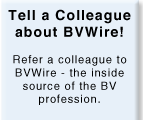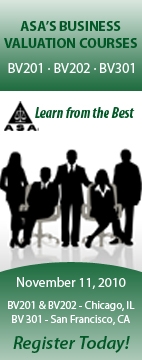
Happy news…ASA and CICBV introduce the International Institute of Business ValuersBig news from Miami yesterday: The ASA and CICBV jointly announced the formation of the IIBV–an association of business valuation associations. With its member associations, IIBV hopes to lead the business valuation profession globally. It’s goals include:
Why the IIBV? It’s no surprise to any one that there’s strong international demand for education and accreditation. There’s also increasing recognition of the IASB, and encouragement of the securities commissions, regulators and users of financial information “around the world.” Groups of appraisers in countries around the world are beginning to organize, and this umbrella group gives them a structure. The ASA Board of Governors, and the CICBV Board voted the final approval for this new group during the meetings during the last weeks. Individual associations globally can join the new IIBV as an umbrella organization while remaining independent. As Farley Cohen, current CICBV president said, “we hope to promote the stature of these global associations. First targets are in the UK and Australia, and then perhaps Hong Kong. Visit the new umbrella organization at www.iibv.org. Drysdale argues income and market approaches can be reconciled via “CAPG” model“A discount rate and a guideline valuation multiple are both a measure of the cost of capital. This means the market approach and the income approach are the same thing,” Don Drysdale (Drysdale Valuation) told the attendees at the ASA/CICBV Business Valuation Conference Monday in Miami. “If you use the same measure of economic benefit and the same cost of capital, you reconcile the two approaches,” he explained. Drysdale has developed the Comprehensive Adjusted Public Guideline (CAPG) model that helps reconcile the market approach and income approach. According to Drysdale:
As if you didn’t know it, making errors destroys your credibility“Don’t succumb to the temptation to take on work for which you are not sufficiently competent to do,” Bill Quackenbush (Advent Valuation) advised attendees at the ASA/CICVA Business Valuation Conference Monday in Miami. There are many ways to make errors on reports, one of which is mismatching your value inputs. Some of the mistakes he has seen in this area include using income returns and cash flow risks/multiples, pretax returns and after tax risks/multiples, and equity returns and invested capital risks. “Know your valuation theory,” he advised. “I often go back and read Pratt, Hitchner, Trugman and other professional works.” And know your finance, accounting, statistics, and economic theory too, Quackenbush added. “I have a copy of Statistics without Tears on my shelf which I refer to. That book came before Statistics for Dummies,” he laughed. “Making errors not only destroys your credibility,” Quackenbush reminded the audience, “it also does your client a disservice and violates your professional obligations.” Discounts, tax-affecting may not apply to insolvency opinions The bankruptcy saga of the fraud-ridden Doctors Hospital in Chicago has taken yet another intriguing spin. In an opinion by Judge Frank Easterbrook, long respected for “his creative applications of economic theory to legal issues,” according to Professor Robert Lloyd (a contributor to BVR’s Comprehensive Guide to Lost Profits Damages, for Experts and Attorneys, 2010 Ed.), the U.S. Court of Appeals for the 7th Circuit has just decided two issues of first impression among the federal circuits. The first—which has bankruptcy bloggers buzzing, held that the trustee of securitized assets was not a “mere conduit” for the transfer of loan proceeds from the troubled hospital, but was an “initial transferee,” sufficient to fall within the preferential transfer provision of the federal Bankruptcy Code.” If the hospital had made a preferential transfer to Exxon, the [bankruptcy] trustee would sue the corporation—and not its millions of stockholders,” Judge Easterbrook observed. “Similarly with a preferential transfer to a hedge fund,” he added, in what could open the door to suits against such investment pools in the future, regardless of whether they still have assets to tap for any liability payments, or would have to sue investors for reimbursement. The second issue should alert valuation analysts: Until it filed bankruptcy in 2000, the hospital had paid all its debts and posted positive earnings. “Yet the bankruptcy judge concluded that it had been insolvent [since 1997],” Judge Easterbrook observed. “How was that possible?” Even after subtracting $18.5 million for the hospital’s fraud (under investigation in 1997 but not incurred until 2000), the S corporation was still in the black. It took a 40% tax-affecting discount to reach red—and this, the Judge said, “was a mistake.” How much a buyer might pay for a revenue stream does not tell us whether a firm is insolvent, except indirectly. Attorneys on the case could not find one decision, from any court, that applied either a liquidity or a tax-effect discount to the asset side of a corporation’s balance sheet for the purpose of determining solvency—and neither could the Judge. Accordingly, he sent the case back for a determination whether the hospital might have been insolvent at any time before its 2000 bankruptcy. The complete digest of Paloian v. LaSalle Bank, 2010 WL 3363596 (C.A.7)(Aug. 27, 2010) will be in the Nov. 2010 Business Valuation Update™, and a copy of the court opinion will be available at BVLaw™. Valuing an intangible asset? The CAC Monograph is a must read BVWire has mentioned TAF’s monograph series frequently, but Monday at the ASA/CICBV Business Valuation Conference in Miami, Chris Mellon (Delphi Valuation) reviewed the importance of theirThe Identification of Contributory Assets and Calculation of Economic Rents. “If you are involved in the valuation of intangible assets, this monograph is a necessity,” says Mellon. The monograph, issued May 31, 2010, was sponsored by the Appraisal Foundation and developed by a working group of six business appraisers, with support from a Task Force on Best Practices for Valuations in Financial Reporting and a group of Contributors. Of the many components of the monograph outlined by Mellon, Handling Negative Excess Earnings in a Given Year (§3.1.11) is especially important for experts valuing early stage companies or companies with negative earnings. “Valuation specialists should take special care when an individual year’s excess earnings are negative as a result of the application of CACs,” Mellon advised. “In some cases, a negative value may indicate that there is no economic basis for recognizing the asset, he added. “Also, a negative value for an asset within a portfolio of assets may need to be offset against positive values of the remaining assets within the portfolio or recognized as a distinct liability. And a negative excess earnings amount for a given year within a projection period associated with a subject intangible asset should not be disregarded in measuring the fair value of that asset.” The 60-page monograph and the additional CAC Toolkit that expands on the data in the CAC Monograph is on The Appraisal Foundation’s website in the section “Financial Reporting”. ISO publishes new standard on brand valuation Just last week the International Organization for Standardization (ISO) published a new international brand valuation standard, ISO 10668, which specifies required procedures and methods for measuring brand values. The new standard provides a detailed valuation framework, including objectives, the basis of valuation, approaches to valuation, and sources quality data and assumptions,” according to Thayne Forbes (Intangible Business), a member of ISO and a featured speaker at BVR’s recent Summit on Best Practices in Valuing IP in Chicago. The U.S. didn’t participate in the development of ISO 10668, Forbes says. But ISO “is a pretty serious body,” he adds, comprised of the national standards institutes of 163 countries. Germany spearheaded the brand valuation project, which began its work in March 2007 and concluded in December 2009. The new standard is “the only one I know of that is not too technical,” Forbes says. American appraisers “should be aware of it, even if the U.S. doesn’t buy into it, because it sets out a commercial framework for valuing and managing brands. It’s something you should definitely consider,” he adds, and European experts agree. “ISO 10668 is in line with the existing standards like IFRS and OECD,” according to a recent Interbrand post, “but extends them to encompass the legal and behavioral aspects that are so crucial to the practice. . . . ISO 10668 is the only guideline for brand valuation that is relevant to all brand valuation purposes, including strategic brand management, legal transactions, reporting and controlling.” Don’t hang your hat on credit ratings when valuing debt Credit ratings issues by Moody’s, Fitch and the like are a good place to start when performing a discount rate estimation for the contractual cash flow method, but they are not something to hang your hat on, said Tom Krasner (Concise Capital Management) in yesterday’s session “Valuation of Debt – Financial Reporting and Market Considerations” at the ASA/CICBV Business Valuation Conference in Miami. “We spend about 10 seconds on credit ratings then roll up our sleeves and get to work. Credit ratings have the reputation of being conservative and behind the times. As an appraiser you want a view of the future: credit rating agencies have a view of the past,” advised Krasner. Pratt's Stats search form updated to accommodate Canadian transactions As valuators from Canada, the U.S. and many other countries meet in Miami for the ASA/CICBV Business Valuation Conference this week, Pratt Stat's users can now search specifically for Canadian deals. Pratt's Stats has close to 300 Canadian deals, with more to be added regularly this fall, and now the search form allows searchers to target those private company transactions. For more information contact Linda Mendenhall at lindam@bvresources.com. Complete the 2010 BV Firm Best Practices survey now and be counted! BVR surveys the entire profession on financial, compensation, marketing, certification, specialization, and other essential management topics every two years. We started the process again last week and already more than 200 of your peers have completed the questionnaire (we anticipate over 600 firms by the end of the process). It’s the only survey of business valuation firm management available, and the deadline for participating is October 20th. Begin the survey questionnaire now by clicking here (you can return to complete the process at any time if you’re interrupted!). Besides the value to the profession, there are two benefits to providing data:
Free downloads continue to be popular with BVWire readers BVR provides over 90 free articles, papers and standards written by top experts in the field of business valuation. The top ten downloads last month were:
Experts lead lost profits calculations webinar this Friday BVR’s Webinar Series on Damages Essentials kicks off this Friday, October 8 with “Lost Profits Calculations: Methods & Procedures” featuring Robert Gray and James O’Brien (ParenteBeard, LLC). Gray and O’Brien will discuss what every appraiser needs to know when engaging in a lost profits case: from calculations methods and related supporting – and admissible – evidence to the business engagements involved in lost profits work. Designed by Nancy Fannon, the series is the most substantial and complete training in this specialized valuation field ever offered. The first part of the series includes four CPE sessions; you can sign up for them singly or as a series at significant discounts. To register for this or any future session in the series click here. And extra value: you can register for the series plus get the Comprehensive Guide to Lost Profits Damages for Experts and Attorneys, edited by Fannon, for $399 (or with an annual subscription to the on-line guide for $499. Separately, the CPE and Guide would cost over $800. Advanced Summit on BV tracks emerging Issues
For full descriptions of these and all other sessions click here. Walker recommends ESOP Association’s new “Repurchase Obligation and Valuation” report “Repurchase obligations are a hot issue in ESOP valuations,” Donna Walker (Columbia Financial Advisors) told the audience at the ASA/CICBV Business Valuation Conference in Miami. “Many believe that the appraisal profession’s failure to incorporate the RO in an ESOP appraisal will result in an inability for any ESOP company to sustain itself over time,” Walked explained. “As more mature, large ownership ESOPs come to dominate the landscape, governance issues have come to the forefront. We’re going to see increased scrutiny about how appraisers take RO into consideration in the value. ESOP companies won’t just ask you “have you taken the RO into consideration, they are going to ask you how you’ve taken it into consideration.” The RO obligation issue has resulted in the ESOP association’s publication Issue Brief #25: Integrated Relationship of ESOP Repurchase Obligation and Valuation in August 2010. “The publication provides you a good framework on how to deal with RO,” Walker added. The Issue Brief is on the ESOP Association website. Free for members; Non-members may purchase it at the ESOP Store for $12.00. And, there’s always BVR’s recent webinar on ESOP and repurchase obligation issues. And, there’s always BVR’s recent webinar on ESOP and repurchase obligation issues. Looking for discounts to NAV for closed end funds?A great question was recently posed on the BV Professionals Group on LinkedIn. Espen Robak (Pluris Valuation Advisors) and Michael Brown (Jaynes, Reitmeier, Boyd & Therrell) both wrote back to recommend Morningstar. Brown says “you can subscribe to the CEF Module of Morningstar Principia. I believe the annual cost for monthly updates is around $650. It has saved a substantial amount of time for me. You can filter and sort based on many different data points, and the results can be exported directly to excel. It is the best solution I have found for CEF data so far.” Another solution? Joshua Lefcowitz (Alpern Rosenthal) has created his own database by downloading weekly returns from the WSJ. Expert weighs in on valuing private company stock with a related put right Carsten Hoffmann (FMV Opinions) sent a comment in response to last week’s BVWire™ˆ (96-4) piece on case law involving chartable contributions with put rights. Hoffmann responded:
North American M&A activity continues to increase In the recent issue of Grant Thornton’s Dealmaker, Ari Goldschneider (Grant Thornton) reports North America M&A activity increased 54% during the first half of 2010 compared with the same period last year. However, the average disclosed deal value is still considerably lower than its peak in 2007. Goldschneider expects “transaction activity will likely increase in the near future as both strategic and financial players seek to put their excess cash to work in the M&A markets, the credit environment continues to loosen, and the economy continues to recover. Click here for Goldschneider’s article “M&A transaction activity continues to rise in the first half of 2010” and the recent issue of Dealmaker.
To ensure this email is delivered to your inbox, Copyright © 2010 by Business Valuation Resources, LLC
|
|



